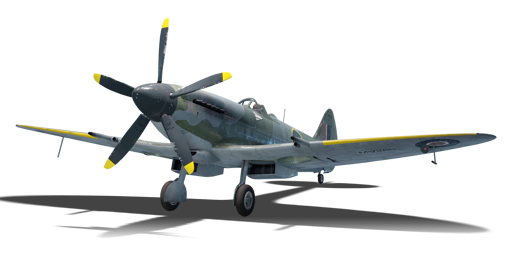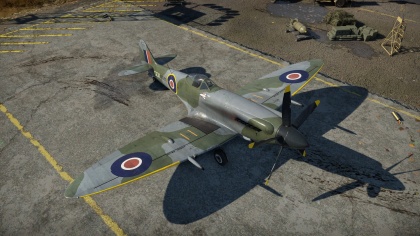Difference between revisions of "Spitfire F Mk XIVe"
(→Flight Performance) (Tag: Visual edit) |
(→Flight Performance) (Tag: Visual edit) |
||
| Line 29: | Line 29: | ||
! RB | ! RB | ||
|- | |- | ||
| − | |691||670|| | + | |691||670||{{Specs|ceiling}}||18.5||19.2||19.1||19.1|| 400 |
|- | |- | ||
! colspan="8" | ''Upgraded'' | ! colspan="8" | ''Upgraded'' | ||
| Line 77: | Line 77: | ||
! - | ! - | ||
|- | |- | ||
| − | | | + | |830||315|| N/A || ~13 || ~8 |
|- | |- | ||
|} | |} | ||
Revision as of 12:56, 3 May 2019
Contents
| This page is about the aircraft Spitfire F Mk XIVe. For other uses, see Spitfire (Disambiguation) |
Description
The Spitfire F Mk XIVe is a Rank IV British fighter
with a battle rating of 5.0 (AB), 5.7 (RB), and 5.3 (SB). This aircraft was introduced in Update 1.41.
General info
Flight Performance
| Characteristics | |||||||
|---|---|---|---|---|---|---|---|
| Stock | |||||||
| Max Speed (km/h at 8,537 m) |
Max altitude (meters) |
Turn time (seconds) |
Rate of climb (meters/second) |
Take-off run (meters) | |||
| AB | RB | AB | RB | AB | RB | ||
| 691 | 670 | 12000 | 18.5 | 19.2 | 19.1 | 19.1 | 400 |
| Upgraded | |||||||
| Max Speed (km/h at 8,537 m) |
Max altitude (meters) | Turn time (seconds) | Rate of climb (meters/second) |
Take-off run (meters) | |||
| AB | RB | AB | RB | AB | RB | ||
| 767 | 723 | 12000 | 16.7 | 17.4 | 32.7 | 24.5 | 400 |
Details
| Features | ||||
|---|---|---|---|---|
| Combat flap | Take-off flap | Landing flap | Air brakes | Arrestor gear |
| X | X | ✓ | X | X |
| Limits | ||||
|---|---|---|---|---|
| Wing-break speed (km/h) |
Gear limit (km/h) |
Combat flap (km/h) |
Max Static G | |
| + | - | |||
| 830 | 315 | N/A | ~13 | ~8 |
| Optimal velocities | |||
|---|---|---|---|
| Ailerons (km/h) |
Rudder (km/h) |
Elevators (km/h) |
Radiator (km/h) |
| < 321 | < 400 | < 470 | > 250 |
| Compressor (RB/SB) | ||
|---|---|---|
| Setting 1 | ||
| Optimal altitude | 100% Engine power | WEP Engine power |
| 4,600 m | 1,510 hp | 2,129 hp |
| Setting 2 | ||
| Optimal altitude | 100% Engine power | WEP Engine power |
| 8,600 m | 1,320 hp | 1,824 hp |
Survivability and armour
- 38 mm Bulletproof glass in cockpit front.
- 4 mm Steel plates in pilot's seat.
- 4-7 mm Steel plates behind the pilot.
- 3 mm Steel boxes around the wing ammunition.
- 12.7 mm Steel plate between fuel tanks.
- 6 mm Steel plate in front of liquid cooling system.
- Critical components located at the front of aircraft (fuel, pilot, engine, controls)
- More fuel tanks located in wings leading edge
Armaments
Offensive armament
The Spitfire F Mk XIVe is armed with:
- 2 x 20 mm Hispano Mk.II cannon, wing-mounted (135 rpg = 270 total)
- 2 x 12.7 mm M2 Browning machine gun, wing-mounted (260 rpg = 520 total)
Suspended armament
The Spitfire F Mk XIVe can be outfitted with the following ordinance:
- Without load
- 1 x G.P. 500 lb Mk.IV bomb
Usage in the battles
Manual Engine Control
| MEC elements | ||||||
|---|---|---|---|---|---|---|
| Mixer | Pitch | Radiator | Supercharger | Turbocharger | ||
| Oil | Water | Type | ||||
| Controllable | Controllable | Not controllable | Controllable | Combined | Controllable | Not controllable |
Modules
| Tier | Flight performance | Survivability | Weaponry | ||
|---|---|---|---|---|---|
| I | Fuselage Repair | Radiator | |||
| II | Compressor | Airframe | |||
| III | Wings Repair | Engine | |||
| IV | Engine Injection | Cover | |||
Pros and cons
Pros:
- Very good at turning, especially at high altitude
- Excellent climb rate
- Very accurate guns when modifications have been researched and equipped
- Lots of ammo for cannons and machine guns
- Very powerful engine that provides a very good acceleration
- Very good dive rate
- Can perform turnfights, BnZ and energy fighting equally.
- Good roll rate.
Cons:
- Performance at low altitude is somewhat inadequate
- Guns perform badly when stock
- Wings are prone to breaking when diving at a very high speed just like any other Spitfire model
- Poor performance and maneuverability at low altitude
- No combat flaps configuration
- Unable to carry ordnance larger than a small bomb
History
The Supermarine Spitfire Mk.XIV was a single engine, single seat fighter which served with the Royal Air Force during the Second World War. In 1941 the Spitfire Mk.IV was the first Spitfire to be trialed with the new Rolls Royce Griffon engine. By the time the Griffon Spitfire entered service with the RAF in February 1943, subsequent modifications had redesignated the aircraft as the Spitfire Mk.XII. As successful as this new Spitfire was at low altitudes, the Mk.XII’s performance was actually inferior to the Merlin engine Mk.IX at medium and high altitudes. Thus, the Spitfire Mk.XIV entered service as an interim fix. Fitted with a Rolls Royce Griffon 65 with two-stage supercharger producing 2050 hp, the Mk.XIV immediately corrected many of the performance shortcomings suffered by the Mk.XII. The fuselage was strengthened to harness the powerful engine and a five bladed Rotol propeller replaced the earlier four bladed examples. Early models were fitted with the Type C wing although later Mk.XIVs were equipped with the Type E wing housing two 20mm Hispano cannons and two .50 caliber Browning machine guns or four 20mm cannons, as well as a high visibility teardrop canopy. A common modification to the Mk.XIV was the clipped wing, which increased roll rate and gave a marginal increase to speed, but at the most of rate of climb.
The Spitfire Mk.XIV entered service with Nos. 91, 322 and 610 Squadrons in southeast England where it saw notable success as an interceptor against V-1 Flying Bombs but also as part of the 2nd Tactical Air Force in operations over occupied Europe. Spitfire Mk.XIVs were also planned for use in the Far East but whilst a number of airframes were shipped to Burma, none were operational before the end of the war. The Spitfire Mk.XIV met mixed reviews from its pilots; whilst there was no doubt of the huge performance increase the new variant offered, it was uncomfortable to fly and lacked the balance and control harmonization of earlier Merlin engine Spitfires. Just under 1000 Spitfire Mk.XIVs were produced with exports being employed by the Air Forces of India, Belgium and Thailand.
Media
An excellent addition to the article will be video guides, as well as screenshots from the game and photos.
Read also
Links to the articles on the War Thunder Wiki that you think will be useful for the reader, for example,
- reference to the series of the aircraft;
- links to approximate analogues of other nations and research trees.
Sources
Paste links to sources and external resources, such as:
- topic on the official game forum;
- page on aircraft encyclopedia;
- other literature.





